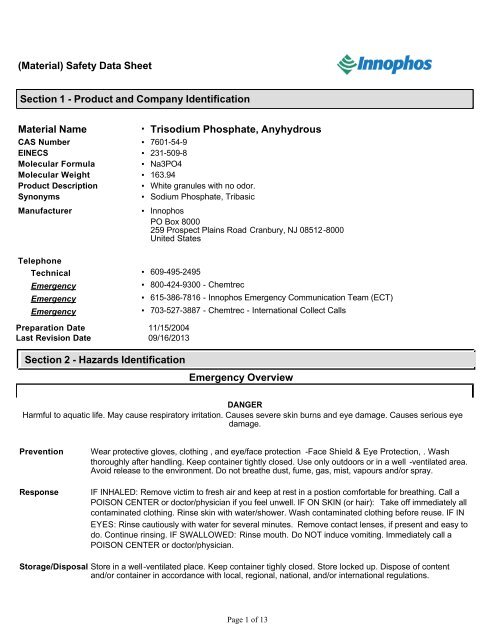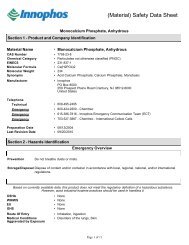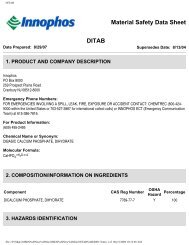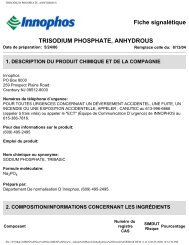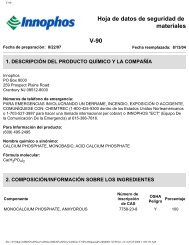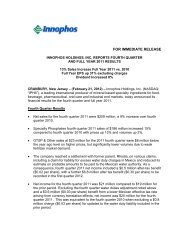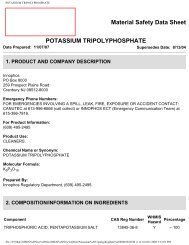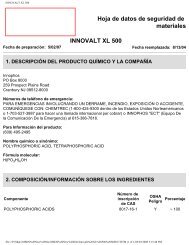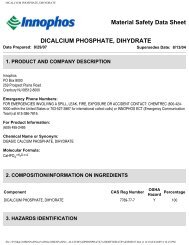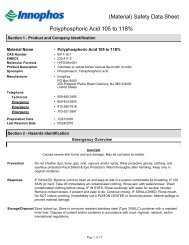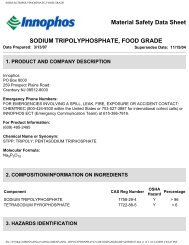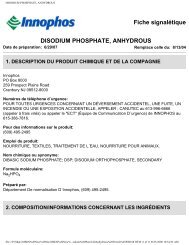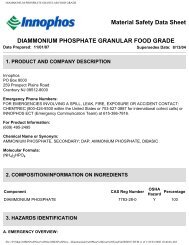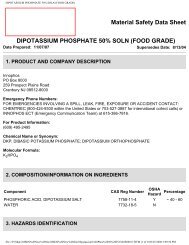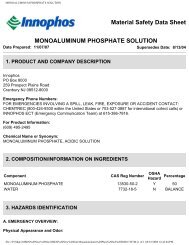Trisodium Phosphate Anhydrous - Innophos
Trisodium Phosphate Anhydrous - Innophos
Trisodium Phosphate Anhydrous - Innophos
Create successful ePaper yourself
Turn your PDF publications into a flip-book with our unique Google optimized e-Paper software.
(Material) Safety Data Sheet<br />
Section 1 - Product and Company Identification<br />
Material Name<br />
▪ <strong>Trisodium</strong> <strong>Phosphate</strong>, Anyhydrous<br />
CAS Number ▪ 7601-54-9<br />
EINECS ▪ 231-509-8<br />
Molecular Formula<br />
▪ Na3PO4<br />
Molecular Weight ▪ 163.94<br />
Product Description<br />
▪ White granules with no odor.<br />
Synonyms<br />
▪ Sodium <strong>Phosphate</strong>, Tribasic<br />
Manufacturer<br />
Telephone<br />
Technical ▪ 609-495-2495<br />
Emergency<br />
Emergency<br />
Emergency<br />
Preparation Date 11/15/2004<br />
Last Revision Date 09/16/2013<br />
▪ <strong>Innophos</strong><br />
PO Box 8000<br />
259 Prospect Plains Road Cranbury, NJ 08512-8000<br />
United States<br />
▪ 800-424-9300 - Chemtrec<br />
▪ 615-386-7816 - <strong>Innophos</strong> Emergency Communication Team (ECT)<br />
▪ 703-527-3887 - Chemtrec - International Collect Calls<br />
Section 2 - Hazards Identification<br />
Emergency Overview<br />
DANGER<br />
Harmful to aquatic life. May cause respiratory irritation. Causes severe skin burns and eye damage. Causes serious eye<br />
damage.<br />
Prevention<br />
Response<br />
Wear protective gloves, clothing , and eye/face protection -Face Shield & Eye Protection, . Wash<br />
thoroughly after handling. Keep container tightly closed. Use only outdoors or in a well -ventilated area.<br />
Avoid release to the environment. Do not breathe dust, fume, gas, mist, vapours and/or spray.<br />
IF INHALED: Remove victim to fresh air and keep at rest in a postion comfortable for breathing. Call a<br />
POISON CENTER or doctor/physician if you feel unwell. IF ON SKIN (or hair): Take off immediately all<br />
contaminated clothing. Rinse skin with water/shower. Wash contaminated clothing before reuse. IF IN<br />
EYES: Rinse cautiously with water for several minutes. Remove contact lenses, if present and easy to<br />
do. Continue rinsing. IF SWALLOWED: Rinse mouth. Do NOT induce vomiting. Immediately call a<br />
POISON CENTER or doctor/physician.<br />
Storage/Disposal Store in a well-ventilated place. Keep container tighly closed. Store locked up. Dispose of content<br />
and/or container in accordance with local, regional, national, and/or international regulations.<br />
Page 1 of 13
OSHA<br />
WHMIS<br />
▪ Corrosive<br />
▪ Class E - Corrosive materials<br />
EU<br />
▪ Dangerous to the Environment - N, Corrosive - C<br />
R52, R34, R37<br />
GHS<br />
Route Of Entry<br />
Medical Conditions<br />
Aggravated by Exposure<br />
▪ Acute Hazards to the aquatic environment - Category 3, Specific Target Organ<br />
Toxicity Single Exposure - Category 3, Skin Corrosion/Irritation - Category 1B, Serious<br />
Eye Damage, Eye Irritation - Category 1<br />
▪ Inhalation, Skin, Eye, Ingestion/Oral<br />
▪ Disorders of the lungs, Skin/Dermal,<br />
NFPA:<br />
Potential Health Effects<br />
Inhalation<br />
Acute (Immediate)<br />
Chronic (Delayed)<br />
Skin<br />
Acute (Immediate)<br />
Chronic (Delayed)<br />
Eye<br />
Acute (Immediate)<br />
Chronic (Delayed)<br />
Ingestion<br />
Acute (Immediate)<br />
Chronic (Delayed)<br />
▪ May cause coughing, chest pain, shortness of breath, upper respiratory tract irritation,<br />
serious damage to lung tissue and respiratory tract.<br />
▪ No data available.<br />
▪ May cause irritation. Irritation is likely to be more severe if the skin is moist or wet.<br />
▪ No data available.<br />
▪ Causes serious eye irritation. May cause burns, irritation, redness, blurred vision.<br />
▪ No data available.<br />
▪ Harmful if ingested. May cause burns to mouth and esophagus, nausea, vomiting, and<br />
diarrhea.<br />
▪ No data available.<br />
Carcinogenic Effects<br />
Potential Environmental<br />
Effects<br />
See Section 12 for Ecological Information.<br />
▪ This product does not contain any ingredient designated by IARC, NTP, ACGIH or<br />
OSHA as probable or suspected human carcinogens.<br />
▪ May cause harmful effects to aquatic life.<br />
Page 2 of 13
Section 3 - Composition/Information on Ingredients<br />
See Section 11 for Toxicological Information.<br />
Hazardous Components<br />
Chemical Name CAS %(weight) UN;EINECS LD50/LC50<br />
Sodium salt (1:3)<br />
phosphoric acid<br />
EU Classification<br />
& R Phrases<br />
Other<br />
7601-54-9 100% 231-509-8 NDA NDA NDA<br />
Under United States Regulations (29 CFR 1900.1200 - Hazard Communication Standard), this product is considered<br />
hazardous. In Canada, the product mentioned above is considered hazardous under the Workplace Hazardous Materials<br />
Information System (WHMIS). This product is considered dangerous according to the European Directive 67/548/EEC.<br />
According to the Globally Harmonized Standard for Classification and Labeling (GHS) this product is considered<br />
hazardous.<br />
Section 4 - First Aid Measures<br />
Inhalation<br />
Skin<br />
Eye<br />
Ingestion<br />
Notes to Physician<br />
See Section 2 for Potential Health Effects.<br />
▪ Move victim to fresh air. Administer oxygen if breathing is difficult. Give artificial<br />
respiration if victim is not breathing. Seek medical attention.<br />
▪ For minor skin contact, avoid spreading material on unaffected skin. In case of contact<br />
with substance, immediately flush skin with running water for at least 20 minutes.<br />
Wash skin with soap and water. Remove and isolate contaminated clothing and<br />
shoes. Seek medical attention. Wash contaminated clothing before reuse.<br />
▪ In case of contact with substance, immediately flush eyes with running water for at<br />
least 20 minutes. Seek immediate medical attention, preferably with an<br />
ophthalmologist. If the physician is not immediately available, eye irrigation should be<br />
continued for an additional 20 minutes. If it is necessary to transport the patient to a<br />
physician and the eye needs to be bandaged, use a dry sterile cloth pad and cover<br />
both eyes.<br />
▪ If swallowed give 2 -3 glasses of water if victim is conscious and alert. Do not give<br />
anything by mouth to an unconscious person. Do NOT induce vomiting. Seek<br />
immediate medical attention. Do not leave victim unattended. To prevent aspiration of<br />
swallowed product, lay victim on side with head lower than waist. If vomiting occurs<br />
and the victim is conscious, give water to further dilute the chemical. Persons<br />
attending the victim should avoid direct contact with heavily contaminated clothing and<br />
vomitus. Wear impervious gloves while decontaminating skin and hair.<br />
▪ All treatments should be based on observed signs and symptoms of distress in the<br />
patient. Consideration should be given to the possibility that overexposure to materials<br />
other than this product may have occurred. Ingestion of large quantities of phosphate<br />
salts (over 1.0 grams for an adult) may cause an osmotic catharsis resulting in<br />
diarrhea and probable abdominal cramps. Larger doses such as 4 -8 grams will almost<br />
certainly cause these effects in everyone. In healthy individuals most of the ingested<br />
salt will be excreted in the feces with the diarrhea and, thus, not cause any systemic<br />
toxicity. Doses greater than 10 grams hypothetically may cause systemic toxicity.<br />
Treatment should take into consideration both anionic and cation portion of the<br />
molecule.<br />
Section 5 - Fire Fighting Measures<br />
Extinguishing Media<br />
Unsuitable Extinguishing<br />
Media<br />
Firefighting Procedures<br />
▪ Not combustible. Use extinguishing media suitable for surrounding fire.<br />
▪ None known.<br />
▪ Keep unauthorized personnel away.<br />
Stay upwind.<br />
Evacuate residents who are downwind of fire. Dike area to prevent runoff and<br />
contamination of water sources. Dispose of fire control water later. Persons who may<br />
Page 3 of 13
Unusual Fire and Explosion<br />
Hazards<br />
Hazardous Combustion<br />
Products<br />
Protection of Firefighters<br />
have been exposed to contaminated smoke should be immediately examined by a<br />
physician and checked for symptoms of poisoning. The symptoms should not be<br />
mistaken for heat exhaustion or smoke inhalation.<br />
▪ Not combustible.<br />
▪ Oxides of sodium, oxides of phosphorus.<br />
▪ Fire fighters should wear complete protective clothing including self -contained<br />
breathing apparatus.<br />
Section 6 - Accidental Release Measures<br />
Personal Precautions<br />
Emergency Procedures<br />
Environmental Precautions<br />
Containment/Clean-up<br />
Measures<br />
Prohibited Materials<br />
▪ Ventilate enclosed areas. Do not touch damaged containers or spilled material unless<br />
wearing appropriate protective clothing.<br />
▪ Keep unauthorized personnel away. Dike spill using absorbent or impervious materials<br />
such as earth, sand or clay.<br />
▪ Runoff from fire control may cause pollution. Prevent material from entering public<br />
sewer system or any waterways.<br />
▪ Sweep or vacuum up and place in an appropriate closed container.<br />
Clean up residual material by washing area with water and detergent. Collect<br />
washings for disposal.<br />
▪ None known.<br />
Section 7 - Handling and Storage<br />
Handling<br />
▪ Avoid direct or prolonged contact with skin and eyes. Avoid breathing dust. Do not<br />
ingest.<br />
Storage<br />
▪ Store in a tightly closed container. Store in an area that is cool, dry, well -ventilated<br />
and isolated from all toxic and harmful substances.<br />
Special Packaging Materials ▪ No data available<br />
Incompatible Materials or<br />
Ignition Sources<br />
▪ No data available<br />
Section 8 - Exposure Controls/Personal Protection<br />
Personal Protective Equipment<br />
Pictograms<br />
Respiratory<br />
Eye/Face<br />
Hands<br />
Skin/Body<br />
General Industrial Hygiene<br />
Considerations<br />
Engineering<br />
Measures/Controls<br />
▪<br />
▪ Follow the OSHA respirator regulations found in 29 CFR 1910.134 or European<br />
Standard EN 149. Use a NIOSH/MSHA or European Standard EN 149 approved<br />
respirator if exposure limits are exceeded or symptoms are experienced.<br />
▪ Wear face shield and eye protection. Wear splash goggles. An emergency eye wash<br />
must be readily accessible to the work area.<br />
▪ Wear protective gloves -Gloves.<br />
▪ Wear protective clothing<br />
▪ Do not get in eyes or on skin or clothing. Wash thoroughly with soap and water after<br />
handling and before eating, drinking, or using tobacco. Handle in accordance with<br />
good industrial hygiene and safety practice.<br />
▪ Good general ventilation should be used. Ventilation rates should be matched to<br />
conditions. If applicable, use process enclosures, local exhaust ventilation, or other<br />
engineering controls to maintain airborne levels below recommended exposure limits.<br />
If exposure limits have not been established, maintain airborne levels to an acceptable<br />
level.<br />
Page 4 of 13
Exposure Limits/Guidelines<br />
Result ACGIH Argentina Canada Ontario Canada Quebec China<br />
STELs Not established Not established Not established Not established<br />
16 mg/m3 STEL (free<br />
SiO2 10%,<br />
total)<br />
as Particulates not<br />
otherwise classified<br />
<strong>Trisodium</strong><br />
<strong>Phosphate</strong>,<br />
Anyhydrous<br />
7601-54-9<br />
TWAs<br />
10 mg/m3 TWA<br />
(inhalable particles,<br />
recommended); 3<br />
mg/m3 TWA<br />
(respirable particles,<br />
recommended)<br />
as Particulates not<br />
otherwise classified<br />
10 mg/m3 TWA<br />
(inhalable fraction,<br />
particulate matter<br />
containing no<br />
asbestos and less<br />
than 1% crystalline<br />
silica); 3 mg/m3 TWA<br />
(respirable fraction,<br />
particulate matter<br />
containing no<br />
asbestos and less<br />
than 1% crystalline<br />
silica)<br />
10 mg/m3 TWAEV<br />
(inhalable<br />
particulate); 3 mg/m3<br />
TWAEV (respirable<br />
particulate)<br />
as Particulates not<br />
otherwise classified<br />
10 mg/m3 TWAEV<br />
(total dust, containing<br />
no asbestos and less<br />
than 1% crystalline<br />
silica)<br />
as Particulates not<br />
otherwise classified<br />
8 mg/m3 TWA (free<br />
SiO2 10%,<br />
total)<br />
as Particulates not<br />
otherwise classified<br />
as Particulates not<br />
otherwise classified<br />
Exposure Limits/Guidelines (Con't.)<br />
Result Indonesia Malaysia New Zealand OSHA OSHA Vacated<br />
<strong>Trisodium</strong><br />
<strong>Phosphate</strong>,<br />
Anyhydrous<br />
(7601-54-9)<br />
TWAs<br />
10 mg/m3 NAB (not<br />
containing asbestos<br />
and the crystal<br />
content is
Key to abbreviations<br />
MSHA = Mine Safety and Health Administration<br />
NIOSH = National Institute of Occupational Safety and Health<br />
OSHA = Occupational Safety and Health Administration<br />
STEL = Short Term Exposure Limits are based on 15-minute exposures<br />
Section 9 - Physical and Chemical Properties<br />
Physical Form<br />
Appearance/Description<br />
Color : White<br />
Taste : NDA<br />
▪ Solid<br />
▪ White granules with no odor.<br />
Odor : Odorless<br />
Odor Threshold : NDA<br />
Boiling Point: NDA Vapor Pressure: NDA<br />
Melting Point: > 600 C(> 1112 F) Vapor Density: NDA<br />
Specific Gravity: NDA Evaporation Rate: NDA<br />
Density: NDA VOC (Wt.): NDA<br />
Bulk Density: NDA VOC (Vol.): NDA<br />
pH: 11.5 (@ 1 wt/wt%) Volatiles (Wt.): NDA<br />
Water Solubility: Soluble Volatiles (Vol.): NDA<br />
Solvent Solubility: NDA Flash Point: NDA<br />
Viscosity: NDA Flash Point Test Type: NDA<br />
Half-Life: NDA UEL: NDA<br />
Octanol/Water Partition<br />
coefficient:<br />
Coefficient of water/oil<br />
distribution:<br />
NDA LEL: NDA<br />
NDA Autoignition: NDA<br />
Bioaccumulation Factor: NDA Bioconcentration Factor: NDA<br />
Biochemical Oxygen<br />
Demand BOD/BOD5:<br />
NDA<br />
Chemical Oxygen<br />
Demand:<br />
Persistence: NDA Degradation: NDA<br />
NDA<br />
Section 10 - Stability and Reactivity<br />
Stability<br />
Hazardous Polymerization<br />
Conditions to Avoid<br />
Incompatible Materials<br />
Hazardous Decomposition<br />
Products<br />
▪ Stable<br />
▪ Hazardous polymerization will not occur.<br />
▪ Moisture.<br />
▪ Strong acds, magnesium.<br />
▪ Oxides of phosphorus. Oxides of sodium.<br />
Section 11 - Toxicological Information<br />
<strong>Trisodium</strong> <strong>Phosphate</strong>, Anyhydrous 7601-54-9<br />
Page 6 of 13
Test Type Dosage Units Route Species Duration Results<br />
Irritation Eye Rabbit NDA NDA<br />
Irritation Skin Rabbit NDA NDA<br />
Test<br />
Class<br />
Severe<br />
irritation,<br />
reversible<br />
Mild<br />
irritation<br />
Acute Toxicity > 7400 mg/kg Ingestion/Oral Rat NDA LD50 NDA NDA<br />
Target<br />
Organs<br />
Acute Toxicity > 300 mg/kg Skin Rabbit NDA LDLo NDA NDA NDA<br />
Mutagen 11 pph Ingestion/Oral<br />
Key to abbreviations<br />
LD<br />
= Lethal Dose<br />
Drosophila<br />
melanogaster<br />
NDA<br />
NDA<br />
NDA NDA NDA NDA NDA<br />
Comments<br />
Data for trisodium<br />
phosphate, dodecahydrate<br />
Data for trisodium<br />
phosphate, dodecahydrate<br />
Data for trisodium<br />
phosphate,dodecahydrate<br />
Section 12 - Ecological Information<br />
<strong>Trisodium</strong> <strong>Phosphate</strong>, Anyhydrous 7601-54-9<br />
Dosage Units Species Species Description Duration Results Comments<br />
28.5 mg/L Fish Gambusia affinis (Western mosquito fish, adult female) 96 Hour(s) LC50 NDA<br />
Ecological Fate<br />
Persistence/Degradability<br />
Bioaccumulation Potential<br />
Mobility in Soil<br />
▪ No data found for product.<br />
▪ No specific biodegradation test data located. While the alkalinity of this material is<br />
readily reduced in natural waters, the resulting phosphate may persist indefinitely or<br />
incorporate into biological systems.<br />
▪ No data found for product.<br />
▪ No data found for product.<br />
Section 13 - Disposal Considerations<br />
Product<br />
▪ Dispose of content and/or container in accordance with local, regional, national, and/or<br />
international regulations.<br />
Section 14 - Transportation Information<br />
DOT - United States - Department of Transportation<br />
Shipping Name: Environmentally Hazardous Substance, Solid, N.O.S.<br />
ID Number: 3077<br />
Hazard Class: 9<br />
Labeling Class: 9<br />
Packing Group: III<br />
This product is regulated for transportation because it contains a reportable quantity of a hazardous substance found in<br />
Appendix A to 49 CFR 172.101. Depending on the amount of the hazardous substance present, certain package sizes<br />
may be exempt from the transport regulations and can be shipped as non -regulated materials. Please check the<br />
ingredient listing to determine if the quantity of hazardous substance present in this product would be regulated in the<br />
package size being shipped.<br />
Section 15 - Regulatory Information<br />
SARA Hazard Classifications ▪ Acute<br />
Page 7 of 13
Risk & Safety Phrases<br />
▪ R34 Causes burns.<br />
R37 Irritating to respiratory system.<br />
S1 Keep locked up.<br />
S26 In case of contact with eyes, rinse immediately with plenty of water and seek<br />
medical advice.<br />
S36/37/39 Wear suitable protective clothing, gloves and eye/face protection.<br />
Inventory<br />
Component CAS Australia AICS Canada DSL Canada NDSL China EU EINECS<br />
Sodium salt (1:3)<br />
phosphoric acid<br />
7601-54-9 No No No No No<br />
Inventory (Con't.)<br />
Component CAS EU ELNICS Japan ENCS Korea KECL New Zealand Philippines PICCS<br />
Sodium salt (1:3)<br />
phosphoric acid<br />
7601-54-9 No No No No No<br />
Inventory (Con't.)<br />
Component CAS Switzerland SWISS TSCA<br />
Sodium salt (1:3)<br />
phosphoric acid<br />
7601-54-9 No No<br />
Australia<br />
Labor<br />
Australia - Hazardous Substances - Substances Requiring Health Surveillance<br />
None Listed<br />
Australia - High Volume Industrial Chemicals List<br />
None Listed<br />
Australia - List of Designated Hazardous Substances - Classification<br />
None Listed<br />
Australia - Major Hazard Facilities - Threshold Quantity (Table 1)<br />
None Listed<br />
Australia - Major Hazard Facilities - Threshold Quantity for Materials (Table 2)<br />
None Listed<br />
Australia - South Australia - Hazardous Substances Prohibited for Specified Uses<br />
None Listed<br />
Australia - South Australia - Hazardous Substances Requiring Health Surveillance<br />
None Listed<br />
Australia - Tasmania - Workplace Health and Safety - Hazardous Substances Prohibited for Specific Uses<br />
None Listed<br />
Australia - Tasmania - Workplace Health and Safety - Hazardous Substances Requiring Health Surveillance<br />
None Listed<br />
Australia - Western Australia - Hazardous Substances Prohibited for Specified Uses<br />
None Listed<br />
Australia - Western Australia - Hazardous Substances Requiring Health Surveillance<br />
None Listed<br />
Environment<br />
Australia - National Pollutant Inventory (NPI) Substance List<br />
None Listed<br />
Australia - Ozone Protection Act - Scheduled Substances<br />
None Listed<br />
Australia - Priority Existing Chemical Program<br />
None Listed<br />
Other<br />
The Australia Group - Export Control List - Chemical Weapons Precursors<br />
None Listed<br />
Page 8 of 13
Canada<br />
Labor<br />
Canada - List of Prohibited and Restricted Cosmetic Ingredients (The Cosmetic Ingredient Hotlist)<br />
None Listed<br />
Canada - WHMIS - Classifications of Substances<br />
● <strong>Trisodium</strong> <strong>Phosphate</strong>,<br />
Anyhydrou (Chemical<br />
Name-<strong>Trisodium</strong><br />
phosphate)<br />
7601-54-9 E<br />
Canada - WHMIS - Ingredient Disclosure List<br />
None Listed<br />
Environment<br />
Canada - CEPA - Priority Substances List<br />
None Listed<br />
Canada - Ozone Depleting Substances - Schedule 3<br />
None Listed<br />
China<br />
Environment<br />
China - Ozone Depleting Substances - First Schedule<br />
None Listed<br />
China - Ozone Depleting Substances - Second Schedule<br />
None Listed<br />
China - Ozone Depleting Substances - Third Schedule<br />
None Listed<br />
Other<br />
China - Annex I & II - Controlled Chemicals Lists<br />
None Listed<br />
China - Classification and Labeling of Dangerous Chemical Substances Commonly Used<br />
None Listed<br />
China - Dangerous Goods List<br />
None Listed<br />
Croatia<br />
Environment<br />
Croatia - Air Quality - Emission Limits for Stationary Sources<br />
None Listed<br />
Croatia - Air Quality - Limit Values for Gaseous Pollutants<br />
None Listed<br />
Croatia - Air Quality - Recommended Values for Gaseous Pollutants<br />
None Listed<br />
Croatia - Ozone Depleting Substances - Annex A, Group I<br />
None Listed<br />
Egypt<br />
Environment<br />
Egypt - Air Pollutants - Emissions Limits - Overall Particles<br />
None Listed<br />
Egypt - Air Pollutants - Maximum Limits<br />
None Listed<br />
Europe<br />
Environment<br />
EU - Substances Depleting the Ozone layer (1005/2009) - Annex I Substances<br />
Page 9 of 13
None Listed<br />
Other<br />
EU - CLP (1272/2008) - Annex VI - Table 3.2 - Classification<br />
None Listed<br />
EU - CLP (1272/2008) - Annex VI - Table 3.2 - Concentration Limits<br />
None Listed<br />
EU - CLP (1272/2008) - Annex VI - Table 3.2 - Labelling<br />
None Listed<br />
India<br />
Environment<br />
India - Hazardous Chemical Rules - List of Hazardous and Toxic Chemicals<br />
None Listed<br />
India - Municipal Waste Regulations - Ambient Air Quality Acceptable Levels<br />
None Listed<br />
India - Ozone Depleting Substances - Schedule I<br />
None Listed<br />
Indonesia<br />
Environment<br />
Indonesia - Hazardous Waste from Non-Specific Sources<br />
None Listed<br />
Indonesia - Hazardous Waste from Specific Sources<br />
None Listed<br />
Japan<br />
Labor<br />
Japan - ISHL Dangerous Substances<br />
None Listed<br />
Japan - ISHL Designated Carcinogens<br />
None Listed<br />
Japan - ISHL Harmful Substances Prohibited for Manufacture<br />
None Listed<br />
Japan - ISHL Notifiable Substances<br />
None Listed<br />
Environment<br />
Japan - Air Pollution Control Law - Emission Standards for Air Pollutants<br />
None Listed<br />
Inventory - Japan - Industrial Safety and Health Law Substances (ISHL)<br />
None Listed<br />
Korea<br />
Labor<br />
Korea - MOE - Harmful Substances<br />
None Listed<br />
Korea - ISHA - Harmful Substances Prohibited for Manufacturing, Importing, Transferring, or Supplying<br />
None Listed<br />
Malaysia<br />
Labor<br />
Malaysia - Control of Industrial Major Accident Hazards - Threshold Quantities<br />
None Listed<br />
Malaysia - Occupational Safety & Health - Risk Phrases<br />
None Listed<br />
Malaysia - Occupational Safety & Health - Safety Phrases<br />
None Listed<br />
Malaysia - Occupational Safety and Health - Prohibition of Use of Substances<br />
Page 10 of 13
None Listed<br />
Environment<br />
Malaysia - Chlorofluorocarbons (CFCs) Prohibition Order<br />
None Listed<br />
Malaysia - Scheduled Wastes<br />
None Listed<br />
Other<br />
Malaysia - Pesticides Act - List of Active Ingredients<br />
None Listed<br />
Mexico<br />
Environment<br />
Mexico - Ecological Criteria for Water Quality - Drinking Water Supply Source<br />
None Listed<br />
Mexico - Ecological Criteria for Water Quality - Protection of Fresh Water Aquatic Life<br />
None Listed<br />
Mexico - Ecological Criteria for Water Quality - Protection of Marine Water Aquatic Life<br />
None Listed<br />
Other<br />
Mexico - Hazard Classifications<br />
None Listed<br />
Mexico - Regulated Substances<br />
None Listed<br />
New Zealand<br />
Other<br />
New Zealand - Ozone Depleting Substances<br />
None Listed<br />
Philippines<br />
Environment<br />
Philippines - Air Quality - Long Term Guidelines for Criteria Pollutants<br />
None Listed<br />
Philippines - Ozone Depleting Substances - Annex A - Group I<br />
None Listed<br />
Other<br />
Philippines - Priority Chemical List<br />
None Listed<br />
Singapore<br />
Labor<br />
Singapore - Factories Act - Medical Examinations<br />
None Listed<br />
Environment<br />
Singapore - Air Impurities Emission Limits<br />
None Listed<br />
Singapore - Hazardous Substance Transport Quantities<br />
None Listed<br />
Singapore - List of Hazardous Substances<br />
None Listed<br />
Singapore - Ozone Depleting Substances - Annex A - Group I<br />
None Listed<br />
Other<br />
Singapore - Corrosive and Explosive Substances - Corrosive Substances<br />
Page 11 of 13
None Listed<br />
South Africa<br />
Labor<br />
South Africa - General Machinery Regulations - Notifiable Substances<br />
None Listed<br />
Taiwan<br />
Environment<br />
Taiwan - Effluent Standards - Maximum Effluent Limitations<br />
None Listed<br />
Taiwan - Toxic Chemical Substances Control Act - Threshold Regulated Quantities<br />
None Listed<br />
Taiwan - Toxic Chemical Substances Control Act - Classification and Control Levels<br />
None Listed<br />
Thailand<br />
Labor<br />
Thailand - Air Contaminant Standards<br />
None Listed<br />
Environment<br />
Thailand - Banned Persistent Organic Pollutants (POPs)<br />
None Listed<br />
Other<br />
Thailand - Hazardous Substances<br />
None Listed<br />
United States<br />
Environment<br />
U.S. - CAA (Clean Air Act) - Class I Ozone Depletors<br />
None Listed<br />
U.S. - CAA (Clean Air Act) - Class II Ozone Depletors<br />
None Listed<br />
U.S. - CERCLA/SARA - Hazardous Substances and their Reportable Quantities<br />
● <strong>Trisodium</strong> <strong>Phosphate</strong>,<br />
Anyhydrou (Chemical<br />
Name-<strong>Trisodium</strong><br />
phosphate)<br />
7601-54-9 5000 lb final RQ; 2270 kg final RQ<br />
U.S. - CERCLA/SARA - Section 302 Extremely Hazardous Substances EPCRA RQs<br />
None Listed<br />
U.S. - CERCLA/SARA - Section 302 Extremely Hazardous Substances TPQs<br />
None Listed<br />
U.S. - RCRA (Resource Conservation & Recovery Act) - List for Hazardous Constituents<br />
None Listed<br />
U.S. - SDWA (Safe Drinking Water Act) - CCL (Contaminant Candidate List)<br />
None Listed<br />
United States - California<br />
Environment<br />
U.S. - California - Proposition 65 - Carcinogens List<br />
None Listed<br />
U.S. - California - Proposition 65 - Developmental Toxicity<br />
None Listed<br />
U.S. - California - Proposition 65 - Maximum Allowable Dose Levels (MADL)<br />
None Listed<br />
Page 12 of 13
U.S. - California - Proposition 65 - Reproductive Toxicity - Female<br />
None Listed<br />
U.S. - California - Proposition 65 - Reproductive Toxicity - Male<br />
None Listed<br />
Vietnam<br />
Environment<br />
Vietnam - Air Quality - Ambient Air Quality Standards<br />
None Listed<br />
Vietnam - Air Quality - Industrial Emission Standards<br />
None Listed<br />
Vietnam - Air Quality - Maximum Allowable Concentration of Highly Hazardous Chemicals<br />
None Listed<br />
Other<br />
Vietnam - Banned Agrochemicals<br />
None Listed<br />
Section 16 - Other Information<br />
Preparation Date 11/15/2004<br />
Last Revision Date 09/16/2013<br />
Disclaimer/Statement of<br />
Liability<br />
▪ The information herein is given in good faith but no warranty, expressed or implied, is<br />
made.<br />
Key to abbreviations<br />
NDA = No Data Available<br />
Page 13 of 13


